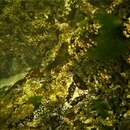Diagnostic Description
provided by Fishbase
With fewer than 70 dentary incisors and a reticulated color pattern.
Life Cycle
provided by Fishbase
Oviparous, distinct pairing (Ref. 205).
Morphology
provided by Fishbase
Dorsal spines (total): 11 - 13; Dorsal soft rays (total): 16 - 18; Anal spines: 2; Analsoft rays: 18 - 20
Trophic Strategy
provided by Fishbase
Inhabits rocky coasts. Feeds on plants, small mollusks and crustaceans.
- Recorder
- Drina Sta. Iglesia
Biology
provided by Fishbase
Adults inhabit rocky coasts (Ref. 9280). They feed on plants, small mollusks and crustaceans (Ref. 9280). Oviparous (Ref. 205). Eggs are deposited in mollusk shells or on rocks (Ref. 9280). Larvae are planktonic, often found in shallow, coastal waters (Ref. 94114). Used to prepare a soup called 'borracho' which evokes slight intoxication and tiredness; these effects, however, are of short duration (Ref. 9280).
- Recorder
- Cristina V. Garilao
Importance
provided by Fishbase
fisheries: minor commercial; price category: unknown; price reliability:
- Recorder
- Cristina V. Garilao
Comprehensive Description
provided by Smithsonian Contributions to Zoology
Scartichthys gigas (Steindachner)
Salarias gigas Steindachner, 1876:220 [Callao, Peru; syntypes NMW 73438:1 and 73438:2].
Salarias eques Steindachner, 1898:307 [“Cavanchabai bei Iquique”; holotype ZMB 15658].
Ophioblennius xiphiodon Clark, 1938:183 [Callao, Peru; holotype CAS 5543] [new synonomy].
Ophioblennius mazorkae Hildebrand, 1946:384 [Mazorka Island, Huaura Group, Peru; holotype USNM 128188] [new synonomy].
DIAGNOSIS.—A species of Scartichthys with fewer than 70 dentary incisors and a reticulated color pattern.
DESCRIPTION.—Dorsal fin XI–XIII (XII in 96.6% of specimens),16–18 (17 in 91.9%); anal fin II,18–20 (19 in 80.9%; 18–19 in 99.4%); total procurrent caudal-fin rays 10–16; pelvic fin I,4; vertebrae 10–11 (10 in 99.4%) + 23–25 (24 in 94.6%) = 33–35 (34 in 94.6%); last pleural ribs on vertebral centrum 11–12 (11 in 99.4%); last epipleural rib on vertebral centrum 15–20 (17–19 in 92.9%); anal pterygiophores 2–1–1, 1–2–1, or 1–1–2 (1–2–1 in 75.6%); nuchal cirri 8–19; supraorbital cirri 19–53 (23–39 in 80.0%); nasal cirri 7–15 (7–11 in 95.7%); LL tubes 18–22 (19–21 in 87.5%); last LL tube on caudal-fin base; no scale-like flaps along LL; lower lip smooth mesially (plicate laterally); gill rakers 16–20 (based on 10 specimens); pseudobranchial filaments on one side 9–13 (based on 12 specimens); premaxillary teeth 108–146 (based on 10 specimens); dentary teeth 57–69 (based on 30 specimens); upper lip crenulae approximately 24–31; nuchal cirri in two irregular groups on either side of nape, distance between them approximately equal to diameter of eye; length of first dorsal-fin spine of adults about equal to second in both sexes; dorsal-fin membrane deeply incised above last dorsal-fin spine; dorsal-fin membrane attached to caudal peduncle in advance of caudal fin in adults; cephalic pore system complex (4 or more pores at most positions; number of pores increases with increasing SL); male genital papilla with urogenital orifice located basally between 2 small protuberances on a fleshy swelling behind anus (Figure 14E); maximum SL about 222 mm; ophioblennius larvae with 2–3 canines posteriorly on each dentary; no spots on membrane between anterior dorsal-fin spines.
The smallest mature female (ova ~0.6 mm diameter) examined is ~126 mm SL. Males mature by ~90 mm SL.
COLOR IN ALCOHOL.—Ophioblennius-stage larvae pale with 11 to 13 saddle-like blotches of pigment along dorsal surface of body; distal half of pectoral fin with numerous melanophores on rays and membranes; scattered melanophores at tips of spinous dorsal-fin rays; remainder of fins pale; small pupil-size cluster of melanophores behind midpoint of posterior margin of eye.
Juveniles with about 8 to 10 irregular dark-brown bars separated by pale interspaces along body; head irregularly covered with pale spots and dark-brown bars, large black spot behind posterior margin of orbit, size of spot about half to three-quarters size of eye; dorsal and anal fins dark brown with pale-tipped fin elements; other fins dusky.
Adult color pattern (Figure 18 shows a female) similar to that of juveniles except that the bars on the head and body break up into a reticulated pattern.
COLOR IN LIFE.—A recently collected adult male in alcohol retained some orange color at the distal tips of the dorsal-fin elements. Other colors are unknown.
COMPARISONS.—Scartichthys gigas differs from all other Scartichthys in having fewer than 70 dentary teeth (versus 74 or more) and in having a vermiculated color pattern over head and body (all others have spots or a uniformly pigmented body).
DISTRIBUTION.—Scartichthys gigas occurs from the Pacific coast of Panama (9°N) to Antofagasta, Chile (23°S; Figure 16). It is sympatric with S. viridis in southern Peru and northern Chile, and with S. crapulatus in northern Chile. It has been collected from rocky bottom and artificial hard bottom areas at depths of 1–5 m.
ETYMOLOGY.—The specific epithet, from the Latin gigas (giant), refers to the relatively large size of adults.
NOMENCLATURAL
- bibliographic citation
- Williams, Jeffrey T. 1990. "Phylogenetic relationships and revision of the blenniid fish genus Scartichthys." Smithsonian Contributions to Zoology. 1-30. https://doi.org/10.5479/si.00810282.492
Scartichthys gigas: Brief Summary
provided by wikipedia EN
Scartichthys gigas, the giant blenny, is a species of combtooth blenny found in the eastern Pacific ocean, from Panama to northern Chile. Members of this species feed primarily off of plants (including benthic algae and weeds), crustaceans, and small mollusks and they themselves are seldom caught for human consumption, as their meat is tasteless. It is said that they can be made into a mildly narcotic soup, therefore their Spanish name borrachilla (drunk). This species reaches a length of 22.2 centimetres (8.7 in) SL.
- license
- cc-by-sa-3.0
- copyright
- Wikipedia authors and editors

